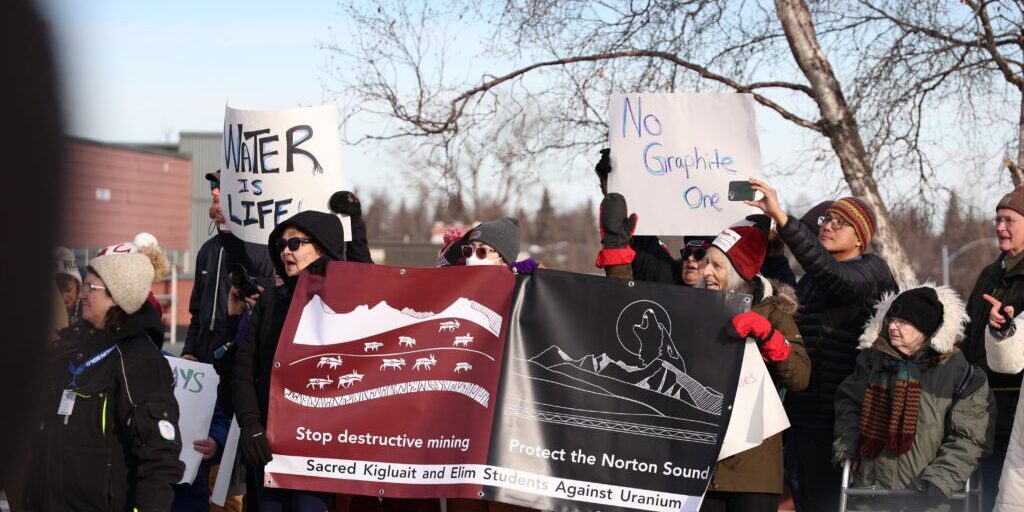The night before the Iditarod’s Ceremonial Start, Ryan Cotter shuffled markers laid out on a giant table at Alaska Community Action on Toxics’ Anchorage office.
“Does the panther like have like a color? Is it a black panther or is it tan?” Cotted asked aloud.
Cotter Googled Panther Minerals’ logo and carefully recreated it on a large white poster. It’s one of many being made across the state protesting the company’s planned project.
Last year the Canadian mining company announced its plans to explore two properties known as Boulder Creek and Fireweed about 30 miles north of Elim on the Seward Peninsula. The sites are known to contain uranium, although the precise deposit size and grade level at each are unknown.
Permitting took much of last summer and now, with state and federal exploration permits in hand, the company plans to begin work this year.

A different company, Triex Minerals, also explored the property in the 2000’s. But that project faced pushback too, from residents fearful of impacts to their subsistence lifestyle and health.
In 2007 the Elim Students Against Uranium group was formed. The group made large paper signs bearing phrases like “No Uranium Mining in Elim” and displayed them at the village’s Iditarod checkpoint.
But after uranium prices peaked and then plummeted that same year, interest in a mine faded away.
When Panther Minerals took over the mining claims last year, Elim resident Emily Murray says she wasn’t surprised.
“We kind of figured they'd be coming in once again to another name,” Murray said. “We did our protests, resolutions to stop it and gained support from people from all over the lower 48.”


17 years later, several organizations are joining forces to protest the exploration activities, including again at this year’s Iditarod.
The protests are aimed at two companies, Panther Minerals and Graphite One. The latter is taking steps toward opening a graphite mine on the Seward Peninsula by the end of the decade. The company hopes its deposit will meet the demand for electric vehicle batteries and other clean energy initiatives.
Jasmine Jemewouk is with the nonprofit Alaska Community Action on Toxics in Anchorage and one of the organizers of the protests. She grew up in Elim and says resource development projects like Panther Minerals and Graphite One are presented as green energy solutions.
“But in the process, they're taking it out of our land, and contaminating our land and contaminating our food,” Jemewouk explained. “That's the concern that we have.”
Jemewouk plans to travel to Elim for another sign-making activity this week. When the Iditarod rolls into town next week, the group hopes to bring awareness to what they believe is an underreported issue.
“That's why we're taking this moment on the global stage to be like, ‘Hey, protect the Norton Sound, no destructive mining’. We are trying our best to protect our indigenous communities and people who will have to deal with the fallout of this,” Jemewouk said.
A group gathered in Anchorage for the ceremonial start and a small contingent demonstrated at the Fairbanks restart too. A final protest by several independent groups is also planned for the Iditarod’s finish in Nome. Panther Minerals did not respond to a request for comment on the planned protests. Graphite One provided the following statement:
Graphite One’s number one priority is the safety and well-being of members of the community and our employees. We understand and respect the fact that the local communities have depended on the area around our deposit for their subsistence way of life for many generations. This is why one of our first actions in 2014 was to form the Subsistence Advisory Committee which includes members from each of the local tribes. This group has been vital in sharing input into how and where these resources are used to help ensure that they are protected.
By continuing to work together to develop the mine and protect the environment and subsistence resources, we will contribute to a better future for the community for generations to come.





